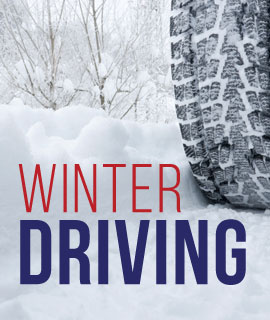Yes, it’s here again—another infamous Nebraska winter. Winter driving can often be hazardous, and for most, it’s just plain scary at times. As it’s nearly impossible for most of us to avoid the nasty weather altogether, it is incredibly important to make sure that your vehicle is prepared accordingly each year.
 When most of us think of winter driving, we think of our tires and specifically whether or not they have enough tread to be considered safe. However, that might depend on who you ask. Many tires claim to be “All Season,” but surprisingly that label doesn’t necessarily account for snow and ice. What does account for this is the “All Weather” designation, which is exclusively used to describe Nokian tires. “All Weather tires are without a doubt necessary for the highest degree of safety for all passengers in your vehicle,” emphasizes Nick Vuko, owner of Walker Tire and Quick Nick’s. “When it comes to winter driving, there are four top things you should pay attention to and those are your four tires. The four tires on your vehicle are the only thing that touches the road, and they will make all the difference in the world for a number of reasons—safety, handling, etc. With that in mind, if customers decide that they want to buy a normal All Season tire that we know isn’t designed for winter, our advice is simple: ‘If there is any chance of ice being present, don’t drive.’ We say this not because you can’t drive forward effectively on ice, but because you won’t be able to turn safely. In fact, over 80% of all accidents that occur during the winter happen when turning. Many consumer reports reflect the results of testing that focuses on stopping, but that doesn’t account for turning—which is a major component of the overall safety rating of a tire! Without a doubt, turning is a major factor in most winter accidents and should be taken very seriously. I encourage you all to look up Nokian at www.nokiantires.com, or better yet, stop in and visit us at Walker Tire. We are able to show you actual comparisons in our showroom, including exactly why most tires on the market (and most likely, the tires that are currently on your vehicle) don’t work for weather conditions that are prevalent during Nebraska winters. Moreover if you are under the impression that it’s impossible to drive safely on ice while still being able to maneuver and control your vehicle, we can prove that to be false as well. The Nokian line of tires is designed and engineered specifically for the upper latitudes—basically, exactly where we live. It is also designed specifically for ice, snow and slush. Another popular myth is that any vehicle that has 4WD is considered to be safe in winter weather. Unfortunately, these vehicles still have a high rate of accidents and that’s still due to improper tires! At Walker Tire, we’ve been in the industry for years and seen a lot of things in that time, including all of the new technology and what has worked well for our customers versus what hasn’t. We won’t look you in the eye and tell you anything that’s not true and we would rather show you instead of tell you anyhow. So to be perfectly safe in the winter, we’ve done our research and we know that the safest tire you can have on your car is the Nokian line carried at Walker Tire. Look them up or stop in and check them out and you’ll see a whole new world of performance.”
When most of us think of winter driving, we think of our tires and specifically whether or not they have enough tread to be considered safe. However, that might depend on who you ask. Many tires claim to be “All Season,” but surprisingly that label doesn’t necessarily account for snow and ice. What does account for this is the “All Weather” designation, which is exclusively used to describe Nokian tires. “All Weather tires are without a doubt necessary for the highest degree of safety for all passengers in your vehicle,” emphasizes Nick Vuko, owner of Walker Tire and Quick Nick’s. “When it comes to winter driving, there are four top things you should pay attention to and those are your four tires. The four tires on your vehicle are the only thing that touches the road, and they will make all the difference in the world for a number of reasons—safety, handling, etc. With that in mind, if customers decide that they want to buy a normal All Season tire that we know isn’t designed for winter, our advice is simple: ‘If there is any chance of ice being present, don’t drive.’ We say this not because you can’t drive forward effectively on ice, but because you won’t be able to turn safely. In fact, over 80% of all accidents that occur during the winter happen when turning. Many consumer reports reflect the results of testing that focuses on stopping, but that doesn’t account for turning—which is a major component of the overall safety rating of a tire! Without a doubt, turning is a major factor in most winter accidents and should be taken very seriously. I encourage you all to look up Nokian at www.nokiantires.com, or better yet, stop in and visit us at Walker Tire. We are able to show you actual comparisons in our showroom, including exactly why most tires on the market (and most likely, the tires that are currently on your vehicle) don’t work for weather conditions that are prevalent during Nebraska winters. Moreover if you are under the impression that it’s impossible to drive safely on ice while still being able to maneuver and control your vehicle, we can prove that to be false as well. The Nokian line of tires is designed and engineered specifically for the upper latitudes—basically, exactly where we live. It is also designed specifically for ice, snow and slush. Another popular myth is that any vehicle that has 4WD is considered to be safe in winter weather. Unfortunately, these vehicles still have a high rate of accidents and that’s still due to improper tires! At Walker Tire, we’ve been in the industry for years and seen a lot of things in that time, including all of the new technology and what has worked well for our customers versus what hasn’t. We won’t look you in the eye and tell you anything that’s not true and we would rather show you instead of tell you anyhow. So to be perfectly safe in the winter, we’ve done our research and we know that the safest tire you can have on your car is the Nokian line carried at Walker Tire. Look them up or stop in and check them out and you’ll see a whole new world of performance.”
 Having the proper insurance coverage may also save the day when it comes to costly damage as a result of accidents which have a significantly higher potential to occur during the winter months. “It is important to be aware of your insurance deductible and limits, and to review this periodically to make sure you aren’t in a situation where you must compensate for inadequate coverage, says David Duff, a local Farm Bureau Financial Services agent. “With Nebraska always having unpredictable weather, I feel that it is also extremely important to encourage regular maintenance on vehicles. If there is a light on the dashboard lit, it is on for a reason. The worst situation is when a car is broke down or there is an accident when it is two degrees outside. Also, ice is a horrible risk that drivers have virtually no control over when operating a vehicle.
Having the proper insurance coverage may also save the day when it comes to costly damage as a result of accidents which have a significantly higher potential to occur during the winter months. “It is important to be aware of your insurance deductible and limits, and to review this periodically to make sure you aren’t in a situation where you must compensate for inadequate coverage, says David Duff, a local Farm Bureau Financial Services agent. “With Nebraska always having unpredictable weather, I feel that it is also extremely important to encourage regular maintenance on vehicles. If there is a light on the dashboard lit, it is on for a reason. The worst situation is when a car is broke down or there is an accident when it is two degrees outside. Also, ice is a horrible risk that drivers have virtually no control over when operating a vehicle.
The safety of a vehicle is always taken into account first and foremost, even by insurance professionals. If you are driving an unsafe car, you are not only being unsafe yourself but you are also a hazard to others on the road. Most insurance plans have the options to account for this, including coverage for all who are affected in the event of an accident. This is a great time of year to reach out to your insurance agent for a reminder of your liability limits and what exactly you are covered for.”
 As you prepare to be on the road this winter, Sherri Stock of inMOTION Auto Care advises that there are three key factors to keep in mind when you’re adapting to winter driving conditions: Visibility, Traction, and Driving Style. She says, “Reduced visibility and traction are the primary factors that make winter driving most difficult. It’s the driving style you choose that will determine how well you cope with the hazards of winter, not to mention the hazards provoked by other drivers.” She also offers a breakdown of the three factors:
As you prepare to be on the road this winter, Sherri Stock of inMOTION Auto Care advises that there are three key factors to keep in mind when you’re adapting to winter driving conditions: Visibility, Traction, and Driving Style. She says, “Reduced visibility and traction are the primary factors that make winter driving most difficult. It’s the driving style you choose that will determine how well you cope with the hazards of winter, not to mention the hazards provoked by other drivers.” She also offers a breakdown of the three factors:
VISIBILITY – Coping with visibility problems needs to begin before you even get behind the wheel. It includes:
• Allow enough time to clear off the snow and ice.
• Clear snow, ice and frost off all the windows, inside and outside.
• Don’t forget mirrors, headlamps and tail lamps.
• Break your wiper blades loose, in front and in the rear if applicable. Failure to do this simple step can shear the splines on the wiper motor, and then your wipers won’t work at all.
• Clear washer nozzle area to allow fluid to reach the windshield.
• Don’t drive with the heater on recirculation mode. Doing so recirculates interior air that keeps increasing in humidity—from melting snow and from your own breath. That moisture-rich air creates frost on the inside of the windows, often faster than the defroster can clear it.
• Be seen. Drive with your headlights on!
TRACTION – All the control you have over your vehicle, whether through the steering wheel, accelerator or the brakes is delivered through four palm-sized patches of rubber where the tires meet the surface of the road. On dry pavement, most of us seldom use more than 30-40% of the traction available. There remains a substantial safety margin so we rarely get into trouble in dry conditions. If we continue to drive the same way in winter conditions that safety margin will not only be diminished, but in many circumstances it will be exceeded. The result: wheel spin, skidding, or both.
This is where DRIVING STYLE comes in. The key to achieving maximum control can be summed up in one word: Smooth! Any quick force applied on the tires, whether through the steering wheel, gas pedal, or brake pedal, can cause a tire to slip or slide. The result: Loss of control. If your vehicle has anti-lock brakes (ABS), read your owner’s manual for operational instructions. NEVER pump the brake pedal if you have ABS brakes. It is also important to note that bridges and overpasses freeze before normal road surfaces, so always be prepared for a change in traction. Always allow additional distance for stopping, as ABS brakes will not make your vehicle stop faster but they will, however, let you stay in control. Also allow additional time to reach your destination, slow down, and avoid making sudden moves including fast turns, hard acceleration and panic stops. If you don’t have time to slow down, do you really have time for an accident?
Stock continues, “What exactly does winterizing mean? Winterizing is a very general term. Preparing a vehicle for winter driving conditions isn’t going to be the same for every vehicle. Actually, it is very much determined by how well you’ve taken care of your vehicle the rest of the year. With regular service and maintenance, you should be able to get by with a fresh oil change, a battery service and a good visual inspection of the components.
Change Engine Oil and Filter — Going into winter with a clean filter and fresh oil will help your engine start better. It will also help reduce component wear inside the engine during longer warm up periods.
Battery Service – A weak battery may get you through the summer, but once the temperature starts to dip, it may leave you stranded. This is because extra amps are needed to start a cold engine in cold weather. Any corrosion build-up on the terminals allows a voltage drain on the battery, and with the prevalent use of ‘maintenance free’ batteries and batteries whose mounting locations are hidden from view, battery inspections and cleanings have become two of the most overlooked maintenance services out there. With that in mind, it’s wise to have your battery cleaned and load tested once a year.
Multi-Point Visual Inspection – It’s always a good idea to check things over while getting the oil changed, and oil change services at inMOTION Auto Care include this inspection at no additional charge. Check points include: • Fluid levels and condition • Tire pressures, tread depth and condition • All exterior lighting • Fluid leaks, engine, transmission and differentials • Battery (if visible) • Belts and Hoses • Air Filter • Wiper Blades • Horn • Exhaust system • Suspension components.
Keep in mind that a good inspection may lead to additional recommended services that left unattended could leave you out in the cold.”
 With the arrival of winter, you may also want to consider some very helpful upgrades to your vehicle. Robert Peinado, owner of GP Customs, offers several examples of products that are great for the colder months:
With the arrival of winter, you may also want to consider some very helpful upgrades to your vehicle. Robert Peinado, owner of GP Customs, offers several examples of products that are great for the colder months:
• We now offer heated windshield washer fluid. This is great for those who must park outside, either at night or at work. It’s a huge inconvenience to scrape your windows, and this is an alternative for those who don’t have a remote starter. The heated washer fluid rapidly defrosts your windshield in around 30 seconds, so you don’t have to worry about scraping it. You can find out more about this product at alphathermusa.com.
• Just in time for the Christmas season we have stocked up on remote car starters. The current technology offered in remote car starters is truly amazing. These systems can be started remotely from long distances, and can even be started from your phone with the corresponding app.
• We also offer heated seats for cars! The kits we have come with a high and low switch, which are added underneath the existing vehicle seating so they maintain the factory look while keeping your butt toasty in the winter/fall months. They operate and look exactly like their factory counterparts, and can be installed in cloth or heated seats in almost any vehicle!
He adds, “Now that winter is finally making its appearance, be sure to check your tires so that you have enough air and tread to help get you out and about safely. Finally, with the holidays upon us I encourage everyone not to drink and drive. If you are at a holiday party or gathering where you plan to drink responsibly, I highly recommend testing yourself prior to leaving. This can be done easily and discreetly using a hand held breathalyzer, which we have available for sale at GP Customs.”
As you can see, there are plenty of ways that you can prepare your vehicle for winter conditions. While it’s important not to drive if you don’t have to when inclement weather strikes, there’s also a number of ways you can ensure that your vehicle is as safe and comfortable as possible during the winter months. It is also important to be prepared with a plan in place in case of emergency, and to stay informed about the expected weather conditions at all times. Always remember, better safe than sorry!

